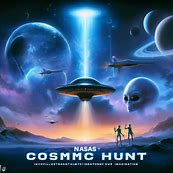The concept of cosmic extraterrestrial life has long captivated the human imagination, sparking curiosity about the potential existence of other worlds. With the boundless expanse of space and uncountable celestial bodies dotting the universe, it appears increasingly probable that we are not alone in this vast cosmos. The notion of distant planets teeming with alien civilizations waiting to be found has inspired scientists and enthusiasts alike.
NASA, the National Aeronautics and Space Administration, is one such organization at the forefront of this quest. Based in the United States, NASA is dedicated to exploring outer space and uncovering answers to age-old questions about our place in the universe. Through innovative technologies and groundbreaking missions, NASA strives to shed light on the mysteries of cosmic existence, propelling humanity’s quest for understanding beyond Earth’s atmosphere.
NASA is dedicated to exploring the cosmic universe beyond our solar system through missions and research. The agency utilizes telescopes, spacecraft, and advanced technologies to study distant stars, galaxies, and exoplanets. By gathering data and information from these cosmic objects, NASA aims to enhance our understanding of the universe and potentially uncover evidence of extraterrestrial life. Through ongoing exploration efforts, NASA continues to push the boundaries of human knowledge about the vast expanse of space.
Index of Contents
ToggleReport by Nasa in september 2023
In September 2023, NASA released a comprehensive report on Unidentified Aerial Phenomena (UAPs), commonly called Unidentified Flying Objects (UFOs). This report was the culmination of an independent study commissioned by NASA in 2022. The report’s primary goal was to offer a scientific analysis and perspective on UAPs, focusing on understanding their cosmic nature and potential origin.
Furthermore, the report aimed to make recommendations for how NASA could systematically collect and analyze data related to UAPs to advance our understanding of these enigmatic phenomena. Notably, the report did not delve into reviewing or assessing specific UAP incidents but instead focused on providing a framework for future investigations.
By addressing this topic from a cosmic standpoint, NASA emphasized the significance of investigating UAPs within the broader space exploration and discovery context. Through its rigorous scientific approach, the agency underscored the importance of applying advanced methodologies and technologies in unraveling the mysteries surrounding UAPs. Ultimately, NASA’s initiative underscored its commitment to shedding light on these puzzling aerial anomalies through systematic research and analysis within the cosmic realm.
The report provided a comprehensive overview of the principles and methodologies employed by the UAP independent study team, comprising 16 community experts across various disciplines. The team meticulously conducted a literature review, engaged with pertinent stakeholders, and organized a public meeting to gather valuable input and feedback from the wider community.
Emphasizing the inherent challenges and compelling opportunities associated with studying cosmic phenomena, the report underscored issues related to the scarcity and quality of available data. It also highlighted the potential for groundbreaking discoveries in this emerging field and the importance of fostering multidisciplinary collaboration in cosmic research.
Quest for understanding our position in this cosmic region
In the cosmic vastness of the universe, the curiosity surrounding the existence of extraterrestrial life has intrigued people worldwide. NASA, the leading authority in space exploration, unveiled a 36-page report on Saturday, September 16, 2023, igniting excitement globally. This comprehensive report is the culmination of a year-long investigation into the possibility of life beyond Earth. Expanding on previous research and incorporating cutting-edge technology, NASA’s findings have reignited the age-old question of whether we are alone in the universe.
As anticipation mounts, people worldwide eagerly await further insights into this captivating subject from NASA and other space organizations. The publication of this report has prompted renewed interest in scientific endeavors aiming to unravel one of humanity’s greatest mysteries – are we truly alone in this vast cosmos? While it may not offer groundbreaking evidence, it delves into crucial aspects fueling the ongoing quest to understand our place in the cosmos.
The report delves into Unidentified Aerial Phenomena (UAPs), also known as UFOs, which have fueled cosmic curiosity for decades. While there is a prevalent belief in their potential extraterrestrial connection, the report takes a neutral stance by categorizing them as UAPs and remaining open to various explanations.
The ongoing fascination with these mysterious occurrences has continued to capture public interest, sparking debates about their possible ties to alien life forms. The study aims to explore the cosmic implications of these phenomena, examining their potential impact on our understanding of the universe and humankind’s place within it. This exploration of UAPs could lead to significant advancements in our comprehension of cosmic phenomena and any potential connections to other intelligent life in the cosmos.
In October of the previous year, NASA made headlines by creating a UFO research team with 16 members. The team’s primary objective was to conduct scientific analyses of reported UFO sightings and assess the possibility of extraterrestrial life. While their findings did not provide conclusive evidence, they emphasized the importance of ongoing cosmic exploration and investigation.
The formation of this specialized group marked a significant milestone in NASA’s efforts to understand potential otherworldly phenomena. By leveraging advanced technology and expertise, the team aimed to examine each meticulously reported UFO sighting to distinguish between natural occurrences and potentially significant discoveries.
Their work sparked renewed interest in cosmic mysteries and catalyzed further study, encouraging collaboration across scientific disciplines. The report highlighted the vast potential for knowledge and understanding beyond Earth’s boundaries, emphasizing the need for continued exploration of our cosmic surroundings. The concluding statement leaves room for speculation: “There is no definitive reason for such phenomena.”
Doubt over existence of extraterrestrial life

The existence of cosmic life is no longer a subject of debate among scientists, who are now focused on when evidence will emerge. Renowned scientist James Webb has been leading a mission on Jupiter’s moon Europa, and he has hinted at the possibility of life existing beyond our solar system. The James Webb Space Telescope recently made an exciting discovery by detecting gases in the atmosphere of Kepler-18b, a planet located 120 light-years away.
These gases resemble those produced by marine life on Earth, sparking further intrigue about the potential for extraterrestrial life. This discovery has sparked great excitement within the scientific community, as it may indicate life beyond our planet. The search for cosmic life continues to captivate the minds and imaginations of researchers and space exploration enthusiasts worldwide.
As technology advances and more powerful telescopes are developed, the pursuit of evidence regarding cosmic life gains momentum. The possibilities are endless, and the potential discoveries are exhilarating for those involved in deep space exploration research. With each new development, we come one step closer to unlocking the mysteries of our universe and uncovering evidence of life beyond Earth.
In conclusion, while the debate about cosmic life has subsided, the quest for concrete evidence remains ongoing as scientists continue to push boundaries and explore new frontiers in their pursuit of knowledge about extraterrestrial existence.
This discovery is significant as it opens up new possibilities for the existence of extraterrestrial life. The Goldilocks Zone, also known as the habitable zone, is an area around a star where conditions are just right for liquid water to exist. This key ingredient is essential for life as we understand it. Catherine Thiemanns, a respected astrophysicist, stresses the importance of focusing our search for cosmic life on planets within this zone.
Recently, scientists have made a breakthrough by identifying a planet called K2-18b within the Goldilocks Zone. With this new finding, researchers can hone in on studying K2-18b and other similar planets to assess their potential for hosting alien life forms. This could bring us closer to uncovering the truth about extraterrestrial life in cosmic space.
Excitement is mounting among scientists as they eagerly await further information about K2-18b, a cosmic body in a distant star’s habitable zone. A specialized team of researchers is gearing up for an in-depth analysis to investigate the detected gases and determine if they could indicate the presence of life on this exoplanet.
The discovery of potential signs of life on K2-18b has sparked discussions about the uniqueness of life on Earth. Many are now contemplating that diverse life forms may exist throughout the universe, challenging previously held assumptions about where and how life can thrive in cosmic environments.
This groundbreaking finding raises profound questions about our place in the cosmos and sparks imagination about the potential variations and adaptations that life could take beyond our planet. The search for extraterrestrial life has gained renewed momentum, as this discovery fuels hope for uncovering new and diverse forms of life beyond our solar system.
As scientific advancements bring us closer to understanding far-off worlds, K2-18b stands as a spectacular example of the mysteries that await us in the depths of space. This pivotal moment underscores the significance and relevance of cosmic exploration in shaping our understanding of existence and broadening our perspective on life’s possibilities beyond Earth.
NASA’s Cosmic Hunt
NASA’s Cosmic Hunt is a series of missions and projects that aim to explore the outer reaches of the galaxy and beyond. These include:
-
- The James Webb Space Telescope (JWST) is set to become the most advanced cosmic observatory, promising groundbreaking discoveries in space exploration. With its planned launch in 2022, this astronomical marvel will harness the power of infrared light to gaze into the depths of the universe. By capturing images in a spectrum invisible to the human eye, it will unveil the earliest galaxies and stars that formed after the Big Bang, offering unprecedented insights into cosmic history.
Moreover, JWST will study planetary systems and their formation, shedding light on our origins and potential for life beyond Earth. It represents a monumental technological achievement, blending intricate engineering with cutting-edge scientific research to unravel some of the cosmos’ greatest mysteries. The telescope’s ambitious mission aims to broaden our understanding of the cosmos and inspire wonder about our place.
Ultimately, JWST’s ability to peer into cosmic events from billions of years ago holds unparalleled promise for advancing humanity’s knowledge of space and expanding our perception of existence. Its anticipated discoveries are poised to reshape our cosmic perspective while fueling excitement about the endless possibilities awaiting exploration beyond our world.
- The Nancy Grace Roman Space Telescope (RST) is set to become the next-generation successor to the Hubble Space Telescope. Scheduled for launch in 2026, it will revolutionize our understanding of the cosmic universe. Equipped with advanced technology, the telescope will conduct comprehensive surveys of the sky in both visible and near-infrared light. By studying dark energy and matter, RST aims to unravel the mysteries behind these fundamental cosmic forces.
Additionally, the telescope’s capabilities extend to exploring exoplanets beyond our solar system, providing valuable insights into their composition and potential habitability. Furthermore, RST will be crucial in observing and documenting cosmic evolution, shedding light on the processes that have shaped our universe over billions of years. With its wide-ranging objectives and cutting-edge features, this groundbreaking telescope represents a significant milestone in cosmic exploration and scientific advancement.
- In 2030, the groundbreaking Interstellar Probe will embark on a mission to journey beyond the heliosphere, marking a historic milestone in space exploration. The heliosphere is a vast bubble of solar wind surrounding our solar system, and venturing beyond it will allow the probe to explore the cosmic wonders of the interstellar medium. With an ambitious goal to travel at least 1000 astronomical units (AU) or roughly 150 billion kilometers from the Sun, the probe will delve into uncharted territory and illuminate the interaction between our solar system and the greater cosmos.
Equipped with state-of-the-art scientific instruments, the Interstellar Probe aims to gather valuable insights into the mysteries of interstellar space. This includes examining cosmic dust, magnetic fields, and radiation as it navigates through this unexplored realm. The Interstellar Probe promises to revolutionize our understanding of our place in the universe while broadening humanity’s cosmic horizons by pushing boundaries and venturing into deep space.
- The Breakthrough Starshot project, spearheaded by private donors, has a cosmic ambition: to send a fleet of miniature spacecraft to Alpha Centauri, our nearest star system. These tiny craft will be propelled with the help of powerful lasers that will accelerate them to an astonishing 20% of the speed of light. As a result, they are expected to reach their destination in about 20 years, surpassing the capabilities of any previous space mission.
To put it into perspective, this interstellar journey would cover a distance of approximately 4.37 light-years. The implications of such an endeavor are immense and could revolutionize our understanding of outer space and the laws of physics. By gaining insights into the interstellar environment surrounding Alpha Centauri, we may gain crucial knowledge pertinent to our understanding of cosmic phenomena.
Despite being incredibly ambitious and challenging, the Breakthrough Starshot project has generated considerable excitement within scientific and public realms due to its pioneering nature. It could open up a new chapter in human exploration beyond our solar system and pave the way for further cosmic endeavors.
Conclusion
These are just some examples of NASA’s Cosmic Hunt, which will expand our knowledge and understanding of the universe and our place in it. By unveiling the extraterrestrial mysteries beyond our imagination, NASA hopes to inspire future generations of explorers and discoverers who will continue the quest for new horizons. In the grand scheme of the cosmos, the quest for understanding our place in the universe continues. NASA’s report serves as a reminder that pursuing knowledge regarding the potential presence of alien life is an ongoing journey filled with uncertainties and possibilities. As we explore the cosmos, the revelation on distant planets and the mystery surrounding UAPs contribute to our evolving understanding of the vast unknown.



